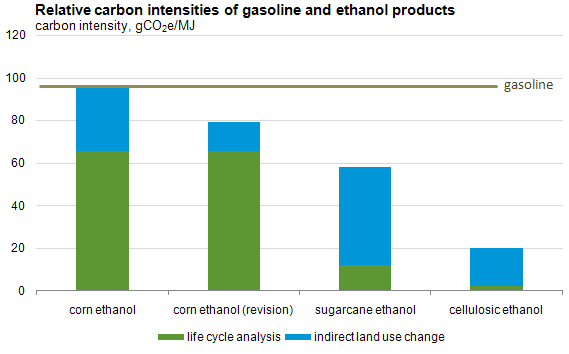
Reduced carbon intensity of corn ethanol may increase its consumption in California

Published by: U.S. Energy Information Administration
California is considering reducing the carbon intensity coefficient associated with corn ethanol, which may increase the amount of corn ethanol consumed for compliance with the State's Low Carbon Fuel Standard. Recent research conducted by Purdue University and Argonne National Laboratory arrived at a lower carbon intensity coefficient for corn ethanol than had previously been calculated.
Growing concern over climate change has spurred various policy initiatives to reduce greenhouse gas emissions, one of which is the Low-Carbon Fuel Standard (LCFS) recently implemented in California. The LCFS requires progressive reductions in carbon intensity for transportation fuels, achieving a 10% reduction in carbon intensity by 2020 relative to 2010. To meet the LCFS, alternative low-carbon fuels such as ethanol, biodiesel, and hydrogen must replace relatively high-carbon, petroleum-based fuels. The relative carbon intensities of these alternative fuels, measured in grams of CO2 equivalent per Megajoule of energy (gCO2e/MJ), determine their usefulness as compliance options.
Carbon intensities account for the carbon dioxide emissions associated with extraction, processing, and distribution over the entire life cycle. One of the most controversial components of this calculation is the Indirect Land Use Change (ILUC) penalty, which attempts to account for potential land-use changes due to increased biofuels production.
The California Air Resources Board is considering adoption of a reduced ILUC penalty for corn ethanol based on research from Purdue University and Argonne National Laboratory examining land use change impacts from corn ethanol production. The primary finding of the recent Purdue study results in corn ethanol's ILUC penalty being reduced from 30 gCO2e/MJ to 13.9 gCO2e/MJ, or by more than half, thereby lowering the carbon intensity coefficient of corn ethanol from 95.66 gCO2e/MJ, almost equivalent to the coefficient for petroleum gasoline, to 79.66 gCO2e/MJ. Other sources of ethanol, such as sugarcane and cellulosic ethanol, have lower carbon intensities and therefore are more effective for LCFS compliance.